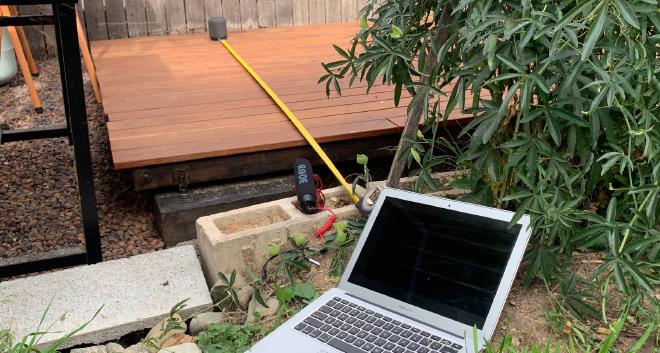Performance

Table of Contents
Quiet Shed - This article is part of a series.
Soundproofing #
To test the soundproofing (sound deadening) performance, the basic idea is to play a loud sound inside, record it outside, and see how much sound was lost in between.
I used Audacity to generate a sequence of pure tones at the standard OITC (Outside Inside Transmission Class, like the well-known STC) sound frequencies, each 0.7 seconds long.
For a baseline measurement in open air I played this through a bluetooth speaker while recording on a microphone (Rode VideoMic) at a distance of 2m. This captures the actual behaviour of the speaker and microphone.

Then I played the same tones through the wall, recording at roughly the same distance (2m). I took recordings at three different locations: low outside the door, low outside the front wall, and high outside a front window.
Before window treatment #
That gave me these sound recordings.

Recordings of pure tones through (1) open air, (2) door, (3) front wall, (4) window. Shown as spectrograms.
As you can see, there is a fair bit of other noise apart from the frequencies being tested. So I extracted the loudness of just those specific frequencies. (In a hacky way: using pixel colour values of the spectrogram image.)
And from that, calculated the transmission loss in decibels compared to open air.

Level of soundproofing i.e. transmission loss at various frequencies. Before window treatment.
This shows:
- the level of soundproofing at less than 40dB is less than I had hoped.
- high frequencies do a bit better - they are easier to block.
- low frequencies do quite well here considering they are usually hard to block. I think the flooring is working.
- the recording at the window is worst overall, confirming that windows are a problem.
After window treatment #
As described on the soundproofing page, I added secondary glazing to all the windows. Then I redid the sound test.

Level of soundproofing i.e. transmission loss near window. DG = double glazing.
The measurement taken near the window did show a clear improvement across almost all frequencies. More sound was blocked.
The measurement taken near the door showed no improvement.
Compared to Pea Hut #
Previously I had built a high-thermal-performance room, the Pea Hut. It has full coverage external insulation of wood fibre, is airtight, and has well-sealed double-glazed uPVC windows. (It also cost nearly 6 times as much to build as this workshop.)

Level of soundproofing i.e. transmission loss compared to the Pea Hut
This shows that the workshop windows are similar to the Pea Hut windows (glazed door) in sound deadening performance. I’m happy with that.
Real sound #
Of course, I’m not planning to play pure tones in my workshop. I recorded the sound of my project vacuum, which is probably the most frequent loud sound I generate. It turns out to be nearly white noise, ie spread across all frequencies.

Spectrogram of vacuum sound inside, then outside with door closed, then inside again.
I recorded the sound inside with the vacuum, and outside with the door closed. The overall volume dropped about 30dB. Subjectively, it is the difference between intolerable and ignorable. I’ll take that.
Conclusions #
Overall this project met its requirements. The soundproofing maybe wasn’t as effective as I hoped it would be, but I don’t regret doing it. Most of the acoustic measures are beneficial for thermal comfort anyway. And I learned a lot.
